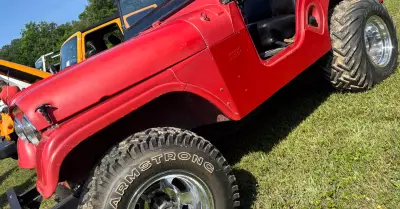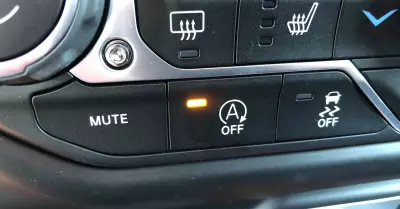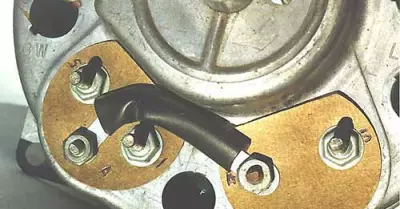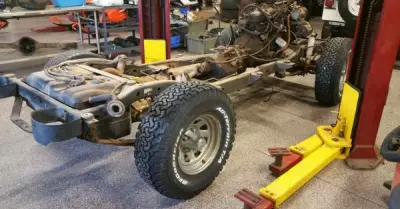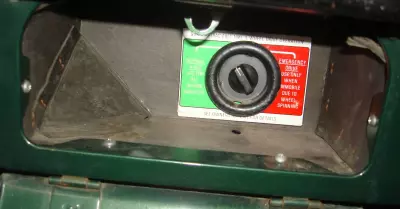We always get questions about a Jeep’s transfer case and it surprises me how many people don’t fully understand what this thing attached to the Jeep’s transmission does. A Jeep transfer case is the mechanical heart of the 4WD system. It’s the part that splits power from the transmission and sends it to the front and rear axles but it doesn’t end there. The transfer case can also reduce the gear ratio to make the Jeep more controllable off road…that’s the bigger magic. Simple in concept, essential in execution. Without it, a Jeep isn’t a Jeep, it’s just a tall station wagon.
Over the decades, Jeep used a variety of transfer cases, gear-driven, chain-driven, part-time, full-time each with its own strengths, quirks, and loyal followers. Here’s how they work and a breakdown of the major models Jeep used from CJ to Wrangler to Cherokee.

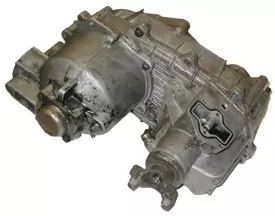
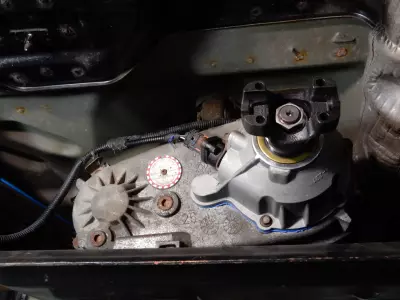
What Does a Transfer Case Do?
At its core, a transfer case mounts to the back of a transmission and has three key jobs:
- Distribute torque to both front and rear axles.
- Allow gear reduction for off-road crawling, typically a 2.03:1, 2.72:1 or 4.0:1 low range.
- Shift between drive modes, such as 2WD, 4HI, Neutral, and 4LO.
Transfer cases come in two basic flavors:
- Part-time 4WD, where the front axle is only engaged when 4WD is selected. Great for off-road and bad weather but shouldn’t be used on dry pavement.
- Full-time 4WD, where all four wheels are powered all the time, often with a differential inside the case to manage power split.
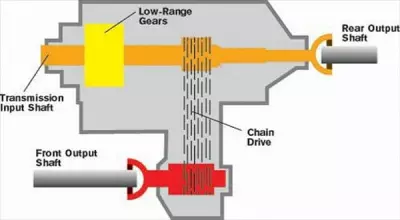
Looking at the above schematic you can see how the power is split within the transfer case – chain or gears.
Common Jeep Transfer Cases by Model
Here’s a breakdown of the most well-known Jeep transfer cases, including where they were used and what made each one special—or frustrating.
Dana 18
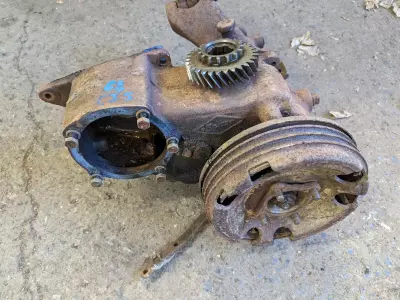
- Used in: CJ2A, CJ3A, CJ3B, early CJ5, Willys wagons
- Drive type: Gear-driven, offset rear output
- Low range: 2.42:1
- Notes: One of the earliest cases. Known for its noisy gear drive and bulletproof build. Requires an offset rear axle due to the passenger-side rear output.
- Identifying: Output yokes on the same part of the case, parking brake assembly, Texas shaped mounting flange.
Dana 20

- Used in: CJ5, CJ6, Commando (mid-to-late 60s through late 70s)
- Drive type: Gear-driven, center rear output, passenger side front output.
- Low range: 2.03:1
- Notes: Tough and compact. Better street manners than the Dana 18 but with a lower crawl ratio. Very popular among CJ enthusiasts doing V8 swaps.
- Identifying: Output yokes separated on case, no parking brake assembly, Texas shaped mounting flange.
Dana 300
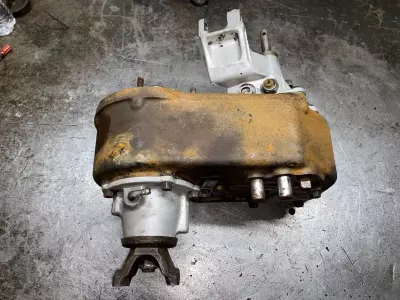
- Used in: CJ7 and CJ8 (1980–1986)
- Drive type: Gear-driven, twin stick capable, center rear output, passenger side front output.
- Low range: 2.62:1
- Notes: The gold standard for many Jeepers. Strong, simple, and easily modifiable. Twin stick conversions allow independent control of front/rear drive—ideal for tight off-road situations. 4:1 conversion kits like we installed in Glenn’s 85 CJ-7 drastically lower the ratio.
- Identifying: Round mounting flange
NP/NV Series – Chain Drive Enters the Picture
NP208
- Used in: Full-size Jeeps like the Wagoneer and J-trucks (early 80s)
- Drive type: Chain-driven, part-time
- Low range: 2.61:1
- Notes: Lightweight and decent for trail use. Less robust than gear drive units but quieter and smoother on-road.
NP231 (a.k.a. NV231)
- Used in: YJ, TJ, XJ, ZJ, KJ (1987–mid 2000s)
- Drive type: Chain-driven, part-time
- Low range: 2.72:1
- Notes: The most common Jeep transfer case. Reliable, plentiful, and simple. Easily upgraded with slip yoke eliminator kits, like we installed on the jeepfan.com 2004 TJ Unlimited. Aftermarket support for the 231 is massive.

NV241
- Used in: JK (2007-2018)
- Drive type: Chain-driven, part-time
- Low range: 2.72:1
- Notes: Reliable and stronger than the NP231. No slip yoke rear output.
NP242 (a.k.a. NV242 or “Selec-Trac”)
- Used in: XJ, ZJ, WJ, Liberty, Commander
- Drive type: Chain-driven, full- and part-time
- Low range: 2.72:1
- Notes: Offers full-time 4WD in addition to standard 2WD, 4HI, and 4LO. A great “set-it-and-forget-it” option for snowy climates and daily drivers.
NV247 (a.k.a. Quadra-Trac II)
- Used in: WJ and WK Grand Cherokee
- Drive type: Full-time only, no 2WD
- Low range: 2.72:1 (if equipped)
- Notes: Uses a gerotor clutch to manage torque split. Works well on-road but lacks the precision and mechanical simplicity off-roaders prefer. Not easily user-serviceable.
NV241OR “Rock-Trac”
- Used in: TJ Rubicon, JK Rubicon, JL Rubicon
- Drive type: Chain-driven, part-time
- Low range: 4.0:1
- Notes: Built for crawling. This is the king of factory Jeep transfer cases. Strong internals, deep gearing, and a fixed rear output. Ideal for serious off-road use and larger tires.
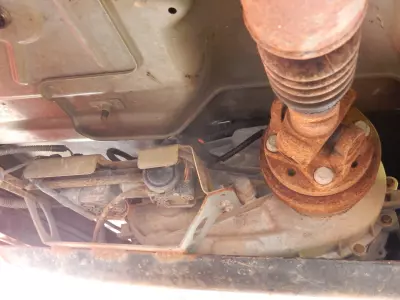
MP3022 & MP3022OR – The New Generation Rock and Snow Units
As Jeep moved into the JL Wrangler and JT Gladiator era, it introduced new transfer case models that blend modern electronics with off-road credibility. These units retain the traditional low-range gearing expected from a Jeep but integrate features designed for traction management in a wider range of conditions.
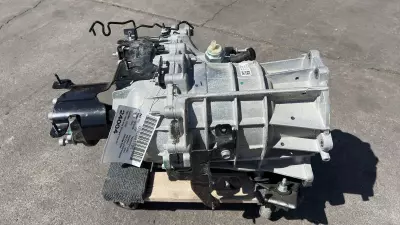
MP3022 (Selec-Trac Full-Time)
- Used in: JL Wrangler Sahara, Gladiator Overland
- Drive type: Full-time 4WD, chain-driven
- Low range: 2.72:1
- Modes: 2WD, 4WD Auto, 4HI, Neutral, 4LO
- Notes: Aimed at daily drivers who see all four seasons. The 4WD Auto mode uses an electronically controlled clutch to automatically engage the front driveshaft when slip is detected. Great for mixed surfaces and variable conditions. While not ideal for hardcore off-roaders, it’s one of the best systems for safety and convenience in winter.
MP3022OR (Rock-Trac Full-Time)
- Used in: JL Rubicon 4xe, some Rubicon and Gladiator Rubicon trims with automatic
- Drive type: Full-time 4WD, chain-driven
- Low range: 4.0:1
- Modes: 2WD, 4WD Auto, 4HI, Neutral, 4LO
- Notes: Think of it as the marriage of the legendary NV241OR Rock-Trac with the daily drivability of Selec-Trac. You still get the deep 4:1 crawl ratio and stout build but gain the convenience of full-time 4WD for rain, snow, and slick pavement. It’s a modern evolution of Jeep capability, especially for rigs that pull double duty as daily drivers and trail machines.
Quick Comparison Table – New School vs. Old School
| Transfer Case | Low Range | Drive Type | Notable Feature |
|---|---|---|---|
| Dana 18 | 2.42:1 | Part-time | Noisy! |
| Dana 20 | 2.03:1 | Part-time | Poor low range ratio but upgradable and tough |
| Dana 300 | 2.72:1 | Part-time | Tough and classic |
| NV231 | 2.72:1 | Part-time | Common and reliable |
| NV241 | 2.72:1 | Part-time | Reliable |
| NP242 | 2.72:1 | Full-/Part-time | Great all-weather capability |
| NV241OR | 4.00:1 | Part-time | Rubicon workhorse, mechanical strength |
| MP3022 | 2.72:1 | Full-time | Auto clutch engagement for daily use |
| MP3022OR | 4.00:1 | Full-time | Rubicon-level gearing + full-time 4WD |
Transfer Case Evolution: Simpler to Smarter?
Over time, Jeep transfer cases evolved from fully mechanical gearboxes to electronically controlled systems with automatic torque split. While this makes newer Jeeps easier to drive in poor conditions, it also introduces complexity and potential weak points. Enthusiasts doing serious trail work often prefer the older mechanical cases for their predictability and durability.
In our opinion both types have their place and the higher tech designs of the newer models have proven reliability so don’t be afraid of them.
Final Thoughts
A Jeep’s transfer case is more than a mechanical box, it’s what makes a Jeep a 4WD machine. Whether you’re wheeling an old CJ with a Dana 300 or daily driving a JL Wrangler Unlimited Rubicon with Selec-Trac, knowing what’s underneath your Jeep matters. All are built to crawl but some are built to really crawl.
Before you hit the trail or tear into a drivetrain upgrade, take a moment to understand the transfer case you’ve got, or the one you want to swap in. It’s the backbone of every great Jeep build.



